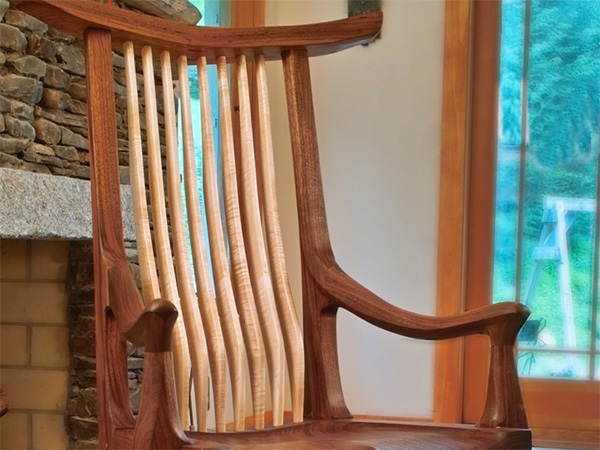
A lot of woodworkers are self-taught, and consequently most of us have learned a lot about the craft from the mistakes we’ve made.
That’s why it was so refreshing to talk with Richard Laufer, a designer and furniture builder who has won awards and whose work is shown in many galleries across the country. Richard was pretty forthcoming about the mistakes he’s made while teaching himself woodworking.
“I didn’t know anything about tools and I found this router. I didn’t know what it was. I couldn’t imagine what you did with it. I knew what sanding was, so I put a disk sander from my drill onto the router. It was just a disaster and the router went flying. So I figured I ought to learn what these tools do,” admits Richard. This was early in his woodworking career, when he was merely interested in fixing up his house and maybe building some furniture.
Then he picked up a woodworking book by Tage Frid, and one thing lead to another. Richard started with plywood and pine and became increasingly intrigued with what he could do with wood. Then he found a book by Moser on Shaker furniture and began to think that he could try his hand at building some of the things he saw in the book. “I learned what you can do with wood and I learned how important it was to do it with accuracy and precision – cutting to a line, using sharp tools ? and not just cutting things freehand. You have to be very, very precise,” says Richard.
Influenced By Everyone
He went on looking through books, and discovering new styles of furniture design that he wanted to learn about. If you were to put together a list of all the people that influenced him during his development as a woodworker, it would look a lot like this:
– Tage Frid
– Thomas Moser (Shaker)
– James Krenov
– Sam Maloof
– George Nakashima
– Frank Lloyd Wright
– Hans Wegner (and Danish Modern style in general)
Richard has learned and borrowed from all of these designers along the way, and they’ve really challenged him to create his own eclectic style. “Furniture is derivative of a lot of different things,” he says, “my experience just blends all of the different styles I’ve been absorbing over the past couple of years.”
His particular interest has been in building and designing chairs and his first successful design was the Blackwater Library Chair (his company is Blackwater Woodworks, named after the Blackwater Wildlife Refuge where he likes to bike). That chair has been the basis for many of the other chairs he’s designed and built. Building a comfortable chair with wood, he says, is a real challenge. You need to understand the many factors that go into building a comfortable chair that’s both functional and looks good. “I’ve got a bunch of chairs in my attic that were done wrong,” Richard admits.
Now, however, when a customer sits in one of his chairs, they can tell how much he’s learned about doing it right. “There are a lot of little things about chairs that I might have been more aware of if I had had training,” he says. “Gradually, you need to become aware of them, like the tilt of the back in relation to the seat.”
Behind Every Good Woodworker
Building furniture may have remained just a hobby for Richard if it hadn’t been for his wife. Unbeknownst to him, she submitted a couple of his chairs to some museums in Philadelphia that were exhibiting wood art from local craftspeople. To his amazement, one of the museums picked one of his chairs, and that got him thinking about his woodworking in a whole new way.
So he entered a couple of pieces in the Philadelphia furniture show about two years ago, and while he didn’t know much about showing his work – or even pricing it – he got a lot a interest from people at the show. He started getting orders from people and had to begin rethinking his career choices. His day job was as a union organizer, which kept him on the road for about 10 months of the year, so something had to give. When he won an award for his Blackwater chair from Niche magazine, he decided to pursue furniture making full time. He still does some consulting work for union organizers, but his chairmaking is keeping him very busy.
Future Challenges
The next challenge for Richard is moving his shop from his house to a very large barn outside of Baltimore due to his backlog of work. He’s worked out of his home for the last five years and doesn’t recommend it. It’s noisy, dusty and difficult to keep your work life separate from your home life. Once he settles into his new shop, he’ll need to find some woodworkers he can hire to help him keep up with demand.
He’s also looking for a few good feet of walnut. While his chairs and furniture are built with cherry and maple, he prefers walnut. And recently he’s been having trouble finding unsteamed walnut. He understands that the steamed walnut has a more uniform color, but he likes to have some sapwood and other variations in the grain for his furniture.
And does he have any advice for all of those other self-taught woodworkers out there? “For people looking to learn how to make this stuff, in my view, you’ve got to actually do it. You’ve got to get whatever tools you need and just go out and get some wood and start making things and figuring out what you’re doing wrong,” says Richard.
– Bob Filipczak





